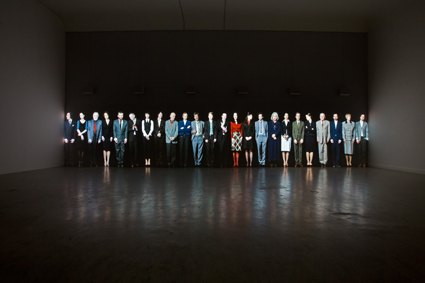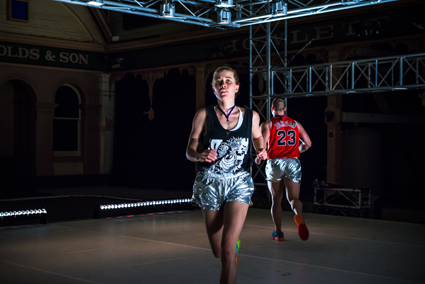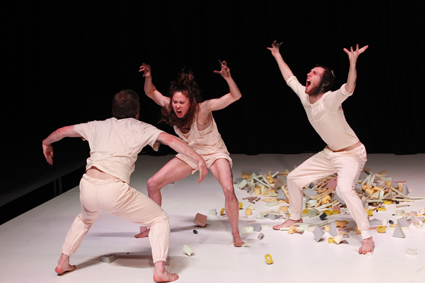Body duress, culture stress
Keith Gallasch: Performance Space: SCORE

Kris Verdonck, Gossip
photo Kristof Vrancken
Kris Verdonck, Gossip
In the absence of Sydney Spring Dance (abandoned by Sydney Opera House after the 2013 season on the grounds of cost), Performance Space has done Australian dance proud in its SCORE season with works by Antony Hamilton, Natalie Abbott, Narelle Benjamin, Gail Priest and Jane McKernan, plus an installation by Belgian director Kris Verdonck. Collectively, the works demonstrated the ever-expanding conceptual and theatrical dimensions of what we understand to be contemporary dance.
Kris Verdonck
Kris Verdonck’s installation-performance video Gossip comprises a human-height screen running the length of a wall in one of Carriageworks’ Tracks. Standing in the otherwise empty, dark space we come face to face with a row of people, including the artist, oddly all of the same (digitally engineered) height though of a fascinating range of body types, physiognomies and fashions that are pretty close to our own. Perhaps they are, like us, a first night audience at the theatre or in a gallery. At first glance they appear to each stand alone, if shoulder to shoulder, some smiling, a few disinterested; but small turns of the head and discreet mouthings while staring directly at us suggest they are passing judgement in pairs and then, in trios and larger ripples along the line, gossip. It’s amusingly discomfiting and fun to witness emergent groupings and surprise when the whole gathering performs unanimously. It’s rather like the pleasure of watching Pina Bausch’s parading of her performers—each figure idiosyncratically attractive to our promiscuous gaze but the whole company enticing in itself.
At the New Media Dramaturgies conference opening on the same night, Verdonck spoke of his audience as “projecting onto his work.” Showing us video of his fascinatingly bizarre creations he described his aim as trying “to get actors to be as authentic as objects,” sometimes submitting them to the unpredictable—a Swan Lake passage in which the dancers are suspended such that they cannot properly execute their moves (“an elegant body-machine”). He imagines an equivalent “actor-machine.” While quite genteel next to Verdonck’s other sometimes violent works (focused, he says, on“one state of being, not an image”), Gossip though cleverly machined is open, subtle and certainly performed.

Natalie Abbott, Donny Henderson-Smith, Maximum
photo Gregory Lorenzutti for Dancehouse
Natalie Abbott, Donny Henderson-Smith, Maximum
Natalie Abbott, Maximum
Maximum, a work of labour-intensive minimalism, exploits the bodies of a dancer, Natalie Abbott, and a bodybuilder, Donny Henderson-Smith, whose cultural and personal aims in life might be very different but who share capacities for precision, strength and endurance. The pair is presented as a team (black singlets, silver shorts, the latest gym footware), jointly exercising to a strict routine that takes them from the unison pacing out of squares, circles and diagonals to a range of exercises, including lunges and, unusual for a gym workout, dance-like toe-pointing, swimming-like floorwork and barking while on all fours. The increasingly demanding exercises climax with a doomed attempt by Henderson-Smith to support Abbott as she stands, leaning far forward, on his thighs—it’s as much an effort for her as for him, her runners losing traction on his slippery shorts. Even before this series of collapses the strain on both performers has been evident, the bodybuilder less able than the dancer to sustain precise movement and rhythm.
Maximum is by turns calculatedly clinical (observe the routines, the sweat, the amplified breathlessness), fascinating (the contrasting body and skill types), funny (satirical at the expense of gym regimes), frustrating (repetition and failure) and—if you empathically ‘run with it’—rewarding. In RealTime Profiler June 30, Abbott told Gail Priest, “It’s about asking an audience to come up to that same level of intensity as the performers, asking [them] to persist with us and engage in a different way than in a more obviously spectacular dance show…” Maximum nonetheless has its share of striking theatricality: a stark white tarquette and a low-slung stylish lighting grid (the lights symmetrically arranged in the current fashion) comprise a perfect starkly illuminated cube suggestive of both gym and laboratory. Dan Arnott’s live sound likewise heightens our attentiveness, homing in on and treating the sounds of bodies at work.
While a logical extension of Abbott’s impressive Physical Fractals (RT114; identical-looking dancers working in unison and generating the sounds that Arnott treats), Maximum is not so obviously a dance work but it is the creation of a choreographic sensibility. It’s interesting to see that the dramaturg for Maximum is Matthew Day, an exponent of very idiosyncratically shaped works to which no obvious meaning can be attached however suggestive they are moment by moment in the dancer’s intensely vibrating body. Unlike Physical Fractals and the Day trilogy, Abbott’s Maximum makes visual poetry of something which we can recognise—exercise, its banalities, demands and, possibly, revelations.

Lauren Langlois, Benjamin Hancock, Alisdair Macindoe, Keep Everything, Chunky Move
photo Jeff Busby
Lauren Langlois, Benjamin Hancock, Alisdair Macindoe, Keep Everything, Chunky Move
Chunky Move: Antony Hamilton, Keep Everything
The title of Antony Hamilton’s Keep Everything apparently refers to the choreographer’s desire to use leftover ideas from previous projects in his new work, rather than waste them. That information is incidental but Hamilton does conjure a world in which humans comprise their contemporary condition, their simian ancestry and well-worn fantasies of cyborg selves. We do keep everything, although usually barely aware of it.
As science increasingly details the oscillation between genetic and social forces in our evolution as a species we learn how much of our ancient past is still embodied in us. We keep everything in our DNA and hang onto much of the inherited cultures over which we obsess. We also learned long ago to speculate, thanks to the development of language and the conceptual sharing it allowed. So it’s not surprising that Keep Everything is speculative or that one of the three performers delivers a talk, posing questions about our similarity to other species in terms of social structure, our use of codes, but also pointing to our distinctive preoccupation with meanings and feelings. Elsewhere the performers, computer-like, flawlessly churn out spoken number series or signal eloquently, with human fluidity—but later robotically fast in the exacting dance passage that completes the work. As well, we witness our prancing simian selves, the performers almost but not quite on all fours, and a bizarrely funny dog-man. ‘Everything’ includes not only our past and future but also our affinity with other species.
Steven Mithen in The Singing Neanderthals posits language as having evolved out of gestures, calls and dance. Humans, like some other species, are dancers but we have codified and conceptualised dance and now, more than ever, use it to express ideas of a complex order, well beyond ballet narrative and formalist abstraction. Witness not only Keep Everything but also in the past-present-future vein ADT’s Devolution and Be Your Self and Chunky Move’s Glow and Mortal Engine as well as Hamilton’s post-apocalyptic Black Projects 1 and 2 in which Carl Nilsson-Polias detected an anti-humanist vision (RealTime, Dance Massive, 2013). At the end of Black Projects 1 the two strange graffiti-ists disappear into their art and in part 2 human-like creatures build themselves yet another religion.
Not everything in Keep Everything is dance, which is hardly uncommon these days, but every bit of it is realised by the performers’ virtuosity in dance, movement, speech and song spectacularly framed in a light-sound-sculpture installation. For the opening minutes of the work we stare into a totally familiar landscape on which lie two piles of initially unidentifiable detritus. The enigmatic beauty of the scene is reinforced by waves of smoke and colour shadings that further complicate our vision. After this immersive opening, figures appear, one retrieved from the detritus, and the work’s initial mutability is then amplified over and over as the three humans themselves transform repeatedly in a world that grows more sonically dense (house music, sci-fi-ish massive synth glides and weirder) and barely categorisable, intense comic book colours prompt us to see anew. This is our world made otherworldly, textured simultaneously with popular culture and big questions. But for all the exhilaration engendered by its maker and his dancers and designers, Keep Everything is a closed circuit in which we do not evolve; we simply are—Hamilton expressing a kind of happy fatalism or offering a necessary antidote to the denialism that has sustained humanism’s belief in our species’ superiority and in progress at any cost.
For more about Performance Space’s SCORE see the reviews of Jon Rose’s Ghan Tracks on page 43, Gail Priest and Jane McKernan’s One thing follows another… on page 21 and Narelle Benjamin’s Hiding in Plain Sight above.
Performance Space, SCORE: Gossip, artist Kris Verdonck, 1-10 Aug; Maximum, choreographer, performer Natalie Abbott, performer, collaborator Donny Henderson-Smith, lighting Matthew Adey, sound Dan Arnott, dramaturg Matthew Day, 27-30 Aug; Chunky Move, Keep Everything, director, choreographer Antony Hamilton, performers Benjamin Hancock, Lauren Langlois, Alisdair Macindoe, Mobile lighting Benjamin Cisterne, sound design Julian Hamilton, Kim Moyes, AV design: Robin Fox; Carriageworks, Sydney, 13-16 Aug
RealTime issue #123 Oct-Nov 2014 pg. 20-22






